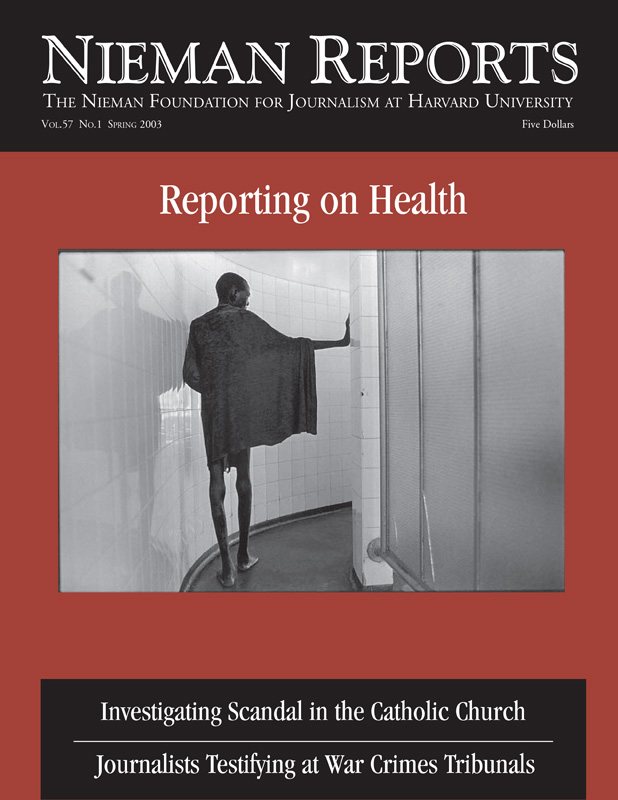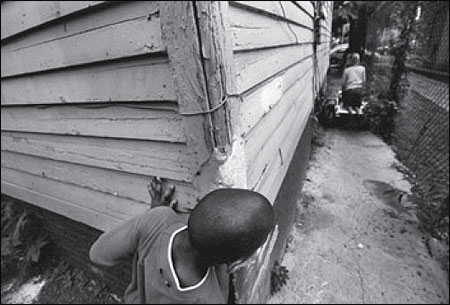
Kids play around Bridget Bornes’s house, which has given her son Allen, 3, background, lead poisoning. The boy in the foreground was visiting his father, who is a tenant in the building. Photo by Mia Song/The Star-Ledger.
My first reaction was that I didn’t want to work on the project my editor at The Star-Ledger was suggesting. I’d done a fairly comprehensive look at lead poisoning in New Jersey a decade before. A good one. The issue had been done to death. This time around it seemed just another case of an editor trying to force new life into a tired, button-pushing ghetto story about the hopelessness that comes when poverty, ignorance and disease converge.
It took me about four hours to change my mind. That was all the time it took to discover that most of the remarkable innovations approved by legislators 10 years earlier—which should have put New Jersey in the national forefront for the prevention of childhood lead poisoning—weren’t actually happening. It was as though the laws they’d passed didn’t exist. Testing hadn’t been done. Abatement never happened. Prevention and education, the only real weapons against this silent but crippling disease, were woefully inadequate. And no one was even sure how bad the problem was because nobody was keeping track.
Within three phone calls, I realized two things: Not only is lead poisoning still the leading childhood environmental disease, but it had expanded beyond the inner city to New Jersey’s suburbs. A recent trend of young, wellto- do families renovating glorious old houses without a clue about lead paint hazards had created more brain-damaged children. Just a few hours of asking questions, and I was already angry that so much money had been spent for studies and so little for treating this most preventable of all killers.
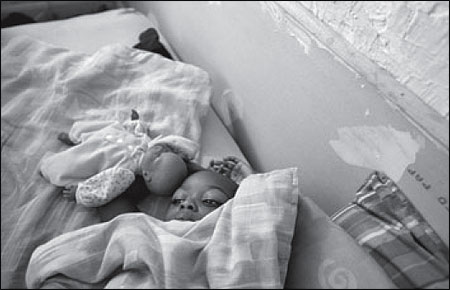
After being released from Beth Israel Hospital for lead poisoning treatment, Allen lies on his mother’s bed next to unfinished repairs in their lead-filled apartment house. Allen was not supposed to return to the apartment due to his lead poisoning, but his mom had few options. Photo by Mia Song/The Star-Ledger.
Taking a Fresh Look
I was ashamed that I hadn’t known about these failures because I never followed up after last reporting on this issue. But now that I knew what I knew, the first job I had was to admit all of this to my editor, let him know I was wrong in my initial negative response to his story suggestion.
My next task was to find a fresh approach to an old reporting project. For at least 40 years, journalists have tried to tell this story; there probably isn’t an environment reporter or a person on the children’s beat who hasn’t done some reporting about lead poisoning. In the six months before we began the project, there had been two brilliant series about this topic, one by The (Baltimore) Sun, the other by The Providence Journal.
So I studied their work. Reporters in Providence, working closely with health officials in Rhode Island, had done exhaustive, computer-assisted analysis of neighborhoods. Baltimore went after major landlords and lobbied successfully for legislative change. Neither approach seemed like the right one for us to take in New Jersey. In our state, laws were already in place; what was missing were the dollars and willpower to implement them. Nor could we track the problem house to house, because health officials refused to identify where known hazards existed.
My editor was pushing for numbers. He had dreams of maps exactly pinpointing problem areas and of slumlords going to jail. Early on, it became obvious that we weren’t going to get the comprehensive statistics that had made the other newspaper’s project so complete. In a way, this circumstance helped us. Unable to focus on the numbers, we examined how the system was supposed to work and where and how it had gone wrong. We discovered that what should have been straightforward—test the children, clean up the houses—was an incredibly complex process with pitfalls almost every step of the way.
I decided to take advantage of the substantial assets we, as a staff, brought to our renewed coverage of this topic. We had an editor willing to give us the time we needed for the kind of reporting that would enable us to do the digging we needed to take a fresh look at this. We had a world-class photographer, Mia Song, with a magical eye for drama, and the reporter I was working with, Russell Ben-Ali, has enviable talents for finding and befriending people and tracking down minute detail.
Ben-Ali’s beat is Newark, the state’s largest and one of its poorest cities. His proposal to do a more modest story about life in the city’s “safe houses” was what actually led to the emergence of this larger project on lead-paint poisoning. These city-owned units were supposed to provide temporary housing for families who were forced to relocate when their children were diagnosed with lead poisoning due to unsafe housing conditions.
New Jersey is one of the few states in the country to offer such homes, and the idea of having them represented a worthy effort to help families and children. But it was turning out that these safe houses were not a success. They ran hugely over budget. Once families moved in, they never moved out, because they couldn’t find decent, leadfree housing. And “safe” house was a misnomer—children were still getting poisoned from lead paint, even while they lived in these houses.
This situation showed me my reporting pathway into this project. From that beginning, we started to get the numbers, examine in detail the programs, chronicle its failures—which turned out to be massive—and recorded its few successes. We learned about the politics, followed the money, studied the research, and tracked the lawsuits. Through all of this, we kept reminding ourselves to never lose sight of the children. They were, after all, whom this public effort was created to protect.
Since I had written my last leadpoisoning project in 1993, I had become a parent. Early on, I realized that having children of my own skewed whatever objectivity I thought I’d brought to my reporting nearly a decade ago. So I decided to let my feelings of outrage act as our guide as we tried to determine what it is our readers—as voters, as citizens, as parents—would want to know.
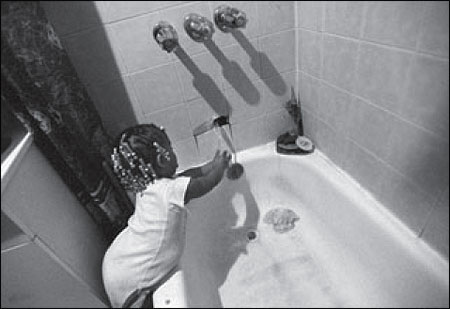
Nyraziah Smith, 2, washes her hands in the bathroom of her family’s apartment. The faucet is missing and the water comes straight out of the wall. Lead poisoning frequently goes hand-in-hand with poor living conditions. Photo by Mia Song/The Star-Ledger.
Reporting the Story
Ben-Ali hit the streets, while I immersed myself in the bureaucratic process and talked with the experts. I also went to clinics where some doctors had been treating lead poisoning for 30 years. They remembered treating generations of children—some from the same families—coming out of the same leadtainted buildings. In one family, three generations of children had been poisoned in the same building. The doctors called these buildings “serial poisoners.”
Soon, I left the clinics and found these buildings. We created databases to track families and landlords. Ben-Ali found the families and gained their trust. He listened and talked with the landlords, too. He visited some of the ugliest parts of Newark late at night, tracking down families who had once lived in these buildings. When he found people with compelling stories, he stayed with them, followed them to court, to welfare offices and clinics. At times, he was there when children were diagnosed with brain-damaging levels of lead and when they were evicted by landlords who refused to remove the lead from their buildings.
My job on this reporting team was to keep track of the details and find documentation. This meant that I registered complaints with the state’s Administrator of the Courts when municipal court workers refused to give us public records. I also filed Freedom of Information requests with city officials who refused to release public health statistics. (These complaints and requests did end up providing invaluable detail, but it took months of paperwork and follow-ups.)
We also pulled city budgets, tracking lead funding. I kept after 10 state and federal agencies as we attempted to follow millions of dollars that had been allegedly spent on lead programs. I was fortunate to get an extraordinary interview with the state’s new health commissioner, who is the father of a lead-poisoned child. He was surprisingly candid about how these programs had failed the children of New Jersey. I also waded through thousands of pages of reports and used census information to pinpoint—to a block-to-block level—where there were neighborhoods filled with housing old enough to be a lead paint hazard.
If I couldn’t portray the total picture, I wanted our smaller stories rendered in exquisite detail. When a case went back 20 years, I wanted to follow it back each step of the way. And every time I documented yet another snafu in the system, Ben-Ali found the children.
As the months progressed, our editors got edgy about getting our reporting into print. Another reporter was added to our team. John Martin went into the suburbs, a daunting task in a home-rule state like New Jersey where each of several hundred municipalities is independent, with its own rules and officials. We had with us lists of suburban houses that had been treated for lead hazards, but addresses were often incorrect or the owners had changed. When we did find parents, they refused to cooperate with us. They were angry, guilt-ridden, and protective of their privacy.
We just kept looking. In higher-income suburbs, we found doctors, lawyers and teachers who had unwittingly exposed their children to dangerously high levels of lead. In fact, the two worst cases of lead poisoning in recent New Jersey history involved children of educated parents in the suburbs. Both familes refused to go on the record. They were ashamed they hadn’t known enough to protect their children and afraid the children would be stigmatized in school if the lead poisoning was made public. These parents did not seem to understand that the levels of lead were so high in their children—10 times what the level of danger is—that it is likely that their children will be too brain-damaged to attend mainstream school. We never could convince those two suburban families to go public, but Martin was hugely successful in finding other families who were more cooperative, even if their circumstances weren’t quite as dramatic.
Photographer Mia Song was with us every step of the way. A Korean immigrant who was still mastering English, Song was lousy with directions and shaky on names. But the pictures—from the very beginning, it was obvious they were special for their clarity and poignancy. She had another, unexpected talent. Small, slender and quietly composed, Song calmed the most nervous parents and children. Once, when Ben-Ali tracked down a man who had survived one of the worst cases of lead poisoning in New Jersey history and I interviewed him, neither of us could convince the family to let us take photographs. Song went to the house and was able to persuade them to let her take pictures. People trusted her.
It was Song’s remarkable pictures that convinced editors this project was worth the extra time. I taped her images to my computer while I wrote, a reminder, as though I needed one by this time, to always remember the children and their parents. And these photographs also reminded me that a good portion of this project was not only about lead poisoning: It was about inner-city families who live in conditions that are unacceptable by any standard.
All of this effort to tell the story the way we believed it needed to be told took several months. But such an investment of time is needed to tell this story. Lead poisoning is still overwhelmingly a disease that afflicts the poor. For many of them, lead is just another lousy break. Gaining their trust means they will call you about all their problems. Failed by the system, many of them look to reporters—who, after all, were some of the first who truly wanted to listen to them—to help fix their broken children. But the ugly fact about lead poisoning is that, once it’s happened, the child can’t be fixed. It also means, to a certain extent, you owe these families. Some still call, looking for help. Often, I have no answer and nothing I can do to help.
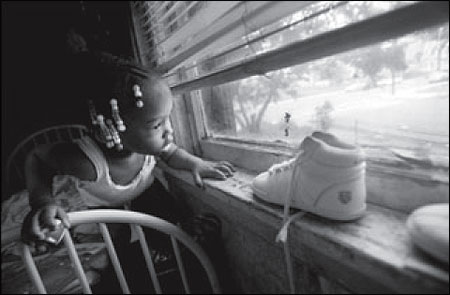
Nyraziah looks out of the paint chipped window of the bedroom.
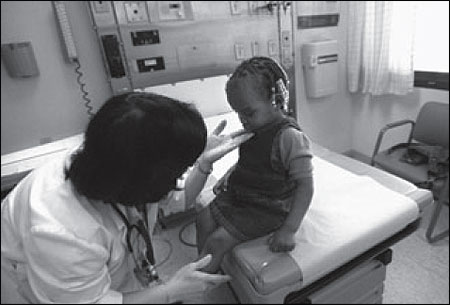
Nyraziah has her regular checkup for her lead level at University Hospital in Newark. She was hospitalized for more than two months in 1999 when her lead level soared. Photos by Mia Song/The Star-Ledger.
Judy Peet is a news feature writer at The Star-Ledger. She and her colleagues won the Garden State Association of Black Journalists Award for community impact for the series on lead poisoning; Mia Song, whose photographs appeared with The Star- Ledger’s story and appear below, is a staff photographer. She was honored as photojournalist of the year by the Sidney Hillman Foundation, and the series won the ARC of New Jersey Community Media Excellence Award for print and photography.
